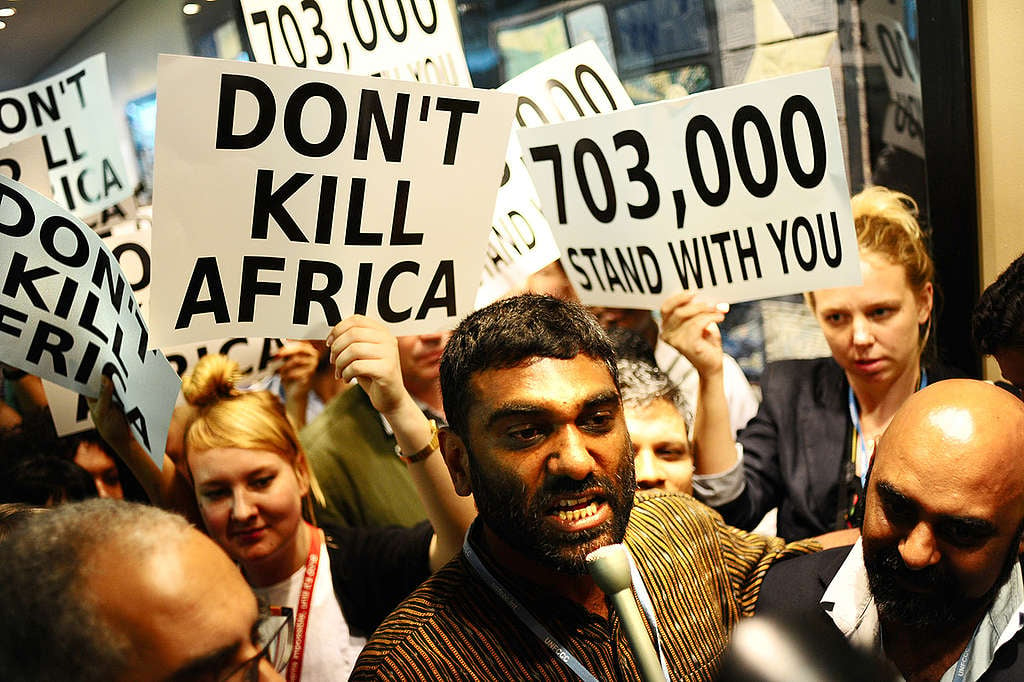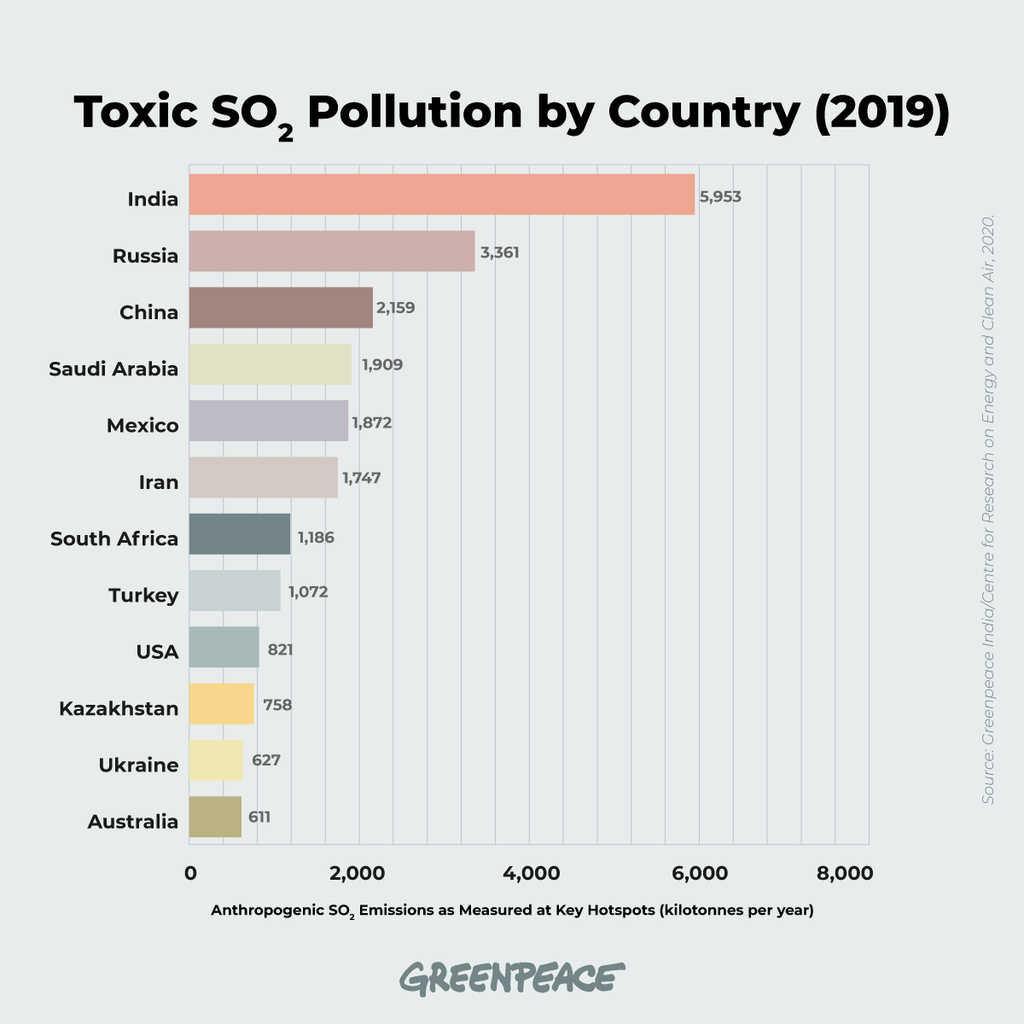International Press Release
Johannesburg, 8 October 2020 – Anthropogenic sulfur dioxide (SO2) emissions fell globally in 2019, reveals a new analysis of NASA satellite data by Greenpeace India and the Centre for Research on Energy and Clean Air (CREA). In 2019 human-made SO2 emissions fell in all three of the world’s top SO2 emitter countries – India, Russia and China – the report shows.
“While heartening at first glance, the drop in emissions is largely not caused by governments doing anything good in the long-term. In South Africa, the drop was caused primarily by load shedding. Coal shows us again and again that it is toxic, unreliable, and costly; if it isn’t completely toxifying our air due to laughably low emission standards, it is causing load shedding. A drop in emissions needs to be accompanied by decisive action from governments across the globe,” said Nhlanhla Sibisi, Climate and Energy Campaigner for Greenpeace Africa.
The report ranks the world’s biggest emitters of sulfur dioxide, a poisonous air pollutant that increases the risk of stroke, heart disease, lung cancer and premature death. [1] [2]
Key findings, based on analysis of NASA satellite data:
- South Africa saw a sharp decrease in SO2 emissions in 2019, bringing the country’s emissions to their lowest level on record. The fall resulted in large part from rolling blackouts, which led to a temporary reduction in coal-fired power generation. [3]
- Anthropogenic SO2 emissions fell by approximately 6% worldwide in 2019. For only the second time on record, anthropogenic SO2 emissions decreased in all of the top three emitter countries: India, Russia and China.
- In 2019, India emitted 21% of global anthropogenic (human-made) SO2 emissions, nearly twice that of the second-ranked global emitter, Russia.
- In 2019, China’s anthropogenic SO2 emissions fell by 5%, the slowest rate of decrease in the past decade. While China was once the world’s biggest emitter of SO2, its emissions have plummeted by 87% since 2011, in large part due to strengthened emissions standards and the use of scrubbers at power plants.
- Anthropogenic SO2 emissions rose 14% in Turkey in 2019, marking the fourth consecutive year of increase. Between 2015 and 2019, Turkey’s share of coal-based electricity production increased by nearly 10%. During this period SO2 emissions doubled.
- In Mexico, anthropogenic SO2 emissions rebounded by 4% in 2019 after a rapid three-year decline. Oil and gas combustion, responsible for 90% of Mexico’s anthropogenic SO2 emissions, increased in 2019.
- In 2019, the Norilsk smelter site in Russia was the biggest source of anthropogenic SO2 emissions in the world. The Rabigh region, an oil and gas-based SO2 emission hotspot in Saudi Arabia, ranked No. 2.
- The Suralaya coal cluster in Banten, Indonesia was the largest SO2 hotspot in Southeast Asia in 2019, followed closely by Singapore’s oil and gas refineries.
“These emissions tracked by satellites are affecting the health of millions of people, many who have had their lives cut short or their health compromised, showing the urgency of implementing stronger emissions regulations and transitioning to clean energy sources. Unfortunately, in some countries topping the list, like India, Mexico and South Africa, governments have continued to delay or weaken the implementation of emissions norms, even as the COVID-19 pandemic should have driven home the importance of respiratory health,” said Lauri Myllyvirta, lead analyst at the Centre for Research on Energy and Clean Air (CREA).
Governments must immediately halt investment in fossil fuels and shift to safer energy sources, such as wind and solar. At the same time, they must strengthen emissions standards and require the application of flue gas pollution control technology at power plants, smelters and other industrial SO2 emitters.
Fig. 1. (below) The world’s 12 largest emitters of toxic SO2 in 2019.
ENDS
Notes:
Find the full report here.
[1] For information on the health impacts of sulfur dioxide see Yang et al., 2014 (https://doi.org/10.1016/j.ijcard.2014.05.044); Shah et al., 2015 (https://doi.org/10.1136/bmj.h1295); Lin et al., 2018 (https://doi.org/10.1038/s41598-018-20404-2); Mandel et al., 2015 (https://doi.org/10.1007/s11684-015-0397-8).
[2] Researchers used NASA satellite data and a global catalogue of SO2 emission sources to detect emission hotspots. NASA’s satellite technology provides near worldwide estimates of SO2 emissions. Researchers analysed the data to identify source industries and emission trends. NASA estimates that the MEaSUREs catalogue, which is the main source for this report, accounts for about half of all known anthropogenic SO2 emissions worldwide.
[3] A detailed, South Africa-specific report will be released on 19 October 2020.
Contact:
Chris Vlavianos, Communications Officer, Greenpeace Africa: [email protected], +2779 883 7036
Greenpeace International Press Desk: [email protected], +31 (0) 20 718 2470 (available 24 hours)
 Get Involved
Get Involved

